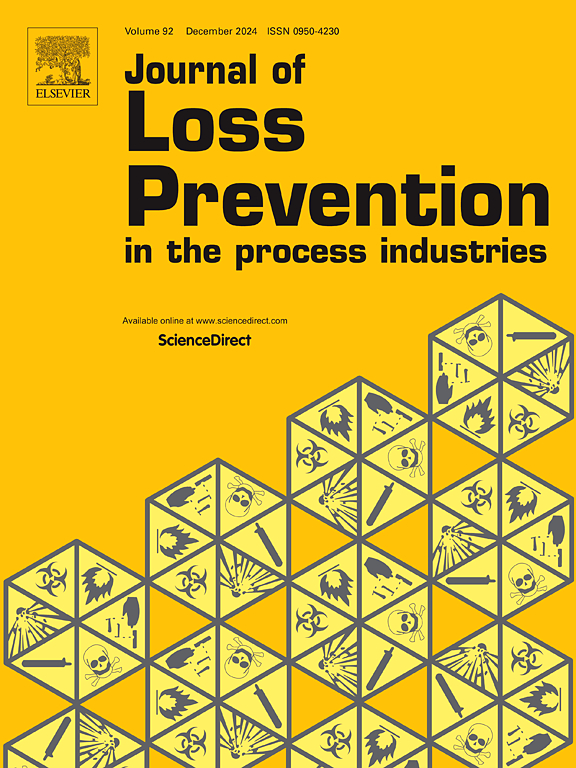An Arrhenius reaction rate based burning model for simulation of dust explosions
IF 3.6
3区 工程技术
Q2 ENGINEERING, CHEMICAL
Journal of Loss Prevention in The Process Industries
Pub Date : 2025-03-26
DOI:10.1016/j.jlp.2025.105638
引用次数: 0
Abstract
The handling of combustible dust poses inherent risks, potentially leading to dust explosions whose strength and consequences hinge on various factors. Computational Fluid Dynamics (CFD) simulations of dust explosions can effectively incorporate these factors, contributing to the design of safer processes and equipment. The FLACS DustEx CFD code has demonstrated notable efficacy in simulating explosions in organic dusts such as maize starch, even in substantial structures like a 236-m3 silo. This code, formerly known as DESC, has been utilized by multiple industries for over a decade. The accurate functioning of the DustEx code relies on the combustion properties of the dust, influenced by factors like dust concentration and particle size. These crucial properties are derived from Pmax and (dP/dt)max values obtained through standardized experimental tests conducted in 20-L and 1-m3 environments.
The enhanced combustion modeling in DustEx comprises three key components. First, the burning rate is linked to an Arrhenius reaction rate based on the product temperature. Second, the impact of particle size distribution and dust concentration on the burning rate is considered by making it a function of the total surface area of all particles. Third, a substantial database at Gexcon is leveraged to formulate the burning rate model across a spectrum of dust types, particle sizes, and dust concentrations. These models are fine-tuned through optimization using least square fitting to align with experimental data.
In contrast to previous iterations of DustEx, which necessitated experimental tests for all combinations of dust concentrations and particle size distributions for each dust sample, the new models significantly reduce the need for such extensive testing. This innovation facilitates a more streamlined process, wherein experimental testing of dusts before CFD simulations can be minimized. The efficacy of these new models has been validated through simulations of large-scale explosion experiments, as well as experiments conducted in 20-L and 1 m3 spherical bombs. This comprehensive testing approach ensures the reliability and applicability of the improved combustion model across a range of scenarios and conditions.
基于Arrhenius反应速率的粉尘爆炸燃烧模拟模型
可燃性粉尘的处理具有固有的风险,可能导致粉尘爆炸,其强度和后果取决于各种因素。粉尘爆炸的计算流体动力学(CFD)模拟可以有效地纳入这些因素,有助于设计更安全的工艺和设备。FLACS DustEx CFD代码在模拟有机粉尘(如玉米淀粉)爆炸方面表现出了显著的有效性,即使是在像236立方米的筒仓这样的实体结构中也是如此。这个代码以前被称为DESC,已经被多个行业使用了十多年。DustEx代码的准确运行依赖于粉尘的燃烧特性,受粉尘浓度和颗粒大小等因素的影响。这些关键特性是通过在20 l和1 m3环境中进行的标准化实验测试获得的Pmax和(dP/dt)max值得出的。在DustEx中增强的燃烧建模包括三个关键组件。首先,燃烧速率与基于产物温度的阿伦尼乌斯反应速率有关。其次,考虑颗粒大小分布和粉尘浓度对燃烧速度的影响,使其成为所有颗粒总表面积的函数。第三,利用Gexcon的大量数据库来制定各种粉尘类型、颗粒大小和粉尘浓度的燃烧速率模型。这些模型通过使用最小二乘拟合的优化进行微调,以与实验数据保持一致。与DustEx之前的迭代相比,需要对每个粉尘样品的所有粉尘浓度和粒径分布组合进行实验测试,新模型显着减少了对这种广泛测试的需求。这一创新有助于简化流程,其中CFD模拟之前的粉尘实验测试可以最小化。这些新模型的有效性已经通过大规模爆炸实验的模拟,以及在20-L和1 m3球形炸弹中进行的实验得到了验证。这种全面的测试方法确保了改进的燃烧模型在一系列场景和条件下的可靠性和适用性。
本文章由计算机程序翻译,如有差异,请以英文原文为准。
求助全文
约1分钟内获得全文
求助全文
来源期刊
CiteScore
7.20
自引率
14.30%
发文量
226
审稿时长
52 days
期刊介绍:
The broad scope of the journal is process safety. Process safety is defined as the prevention and mitigation of process-related injuries and damage arising from process incidents involving fire, explosion and toxic release. Such undesired events occur in the process industries during the use, storage, manufacture, handling, and transportation of highly hazardous chemicals.

 求助内容:
求助内容: 应助结果提醒方式:
应助结果提醒方式:


